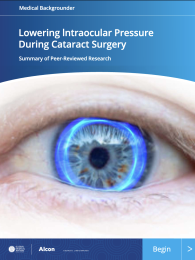

Cataract surgeons historically had to operate at higher infusion pressures to allow for adequate anterior chamber stability with efficient aspiration flow rates and vacuum. Higher pressures helped to compensate for dynamic pressure losses and shallowing of the anterior chamber resulting from flow in gravity-based phacoemulsification systems. The increase in infusion pressure corresponds to an increase in intraoperative IOPs beyond physiological levels, thereby increasing the risk of damaging ocular tissues.
Today’s advanced technology overcomes challenges from gravity-based systems by moving to active fluidics technology and integrated response systems that early detect and compensate for surge effects caused by occlusion breaks. These innovations enable surgeons to operate at a lower intraoperative IOP. This medical backgrounder presents supporting evidence for using near physiologic IOP during cataract surgery to minimize trauma to ocular tissues, improve patient comfort and maintain surgical efficiency.


